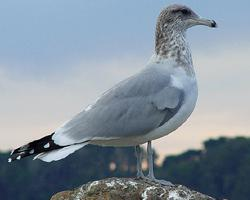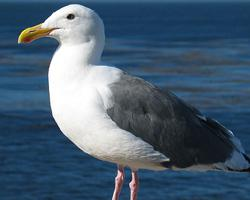
Starea de conservare
| Amenințat |
Descrierea animalului
The California gull (Larus californicus) is a medium-sized bird that belongs to the family Laridae, which encompasses gulls, terns, and skimmers. This species is particularly notable for its adaptability and wide range, primarily found in the western regions of North America, from the Gulf of California in Mexico up through the Pacific coast and inland across many states to the Great Lakes region. It is a bird of many habitats, including oceans, beaches, lakes, rivers, and even agricultural fields and landfills, demonstrating its versatile feeding and nesting behaviors.Physically, the California gull exhibits a blend of characteristic gull features and unique traits that distinguish it from its relatives. Adults typically have a body length of about 18 to 22 inches (45 to 55 cm) and a wingspan ranging from 50 to 54 inches (127 to 137 cm). They possess a sleek, streamlined body with long wings and a moderately long neck. The plumage of the adult California gull during the breeding season is a crisp white on the head and underparts, with a light gray back and upper wings. The wingtips are black with distinctive white spots, known as mirrors. One of the most distinguishing features of this species is the red and black spot on the lower mandible of the yellow bill, which is especially visible during the breeding season. Their legs are a striking greenish-yellow, adding a splash of color to their otherwise muted tones.
Juvenile California gulls go through a series of plumage changes over their first three years of life, starting with a mottled brown and white appearance that gradually transitions to the adult's gray and white. This process allows birdwatchers and researchers to age the birds with some degree of accuracy based on their plumage characteristics.
In terms of behavior, California gulls are opportunistic feeders, their diet varying widely depending on their location and the season. They are known to consume a range of food items, including fish, insects, earthworms, small rodents, and grains. They also display resourcefulness in foraging, sometimes following farm equipment to catch insects and rodents or dropping hard-shelled mollusks onto rocks to break them open. Like many gull species, they are not averse to scavenging and can often be found near human habitations, taking advantage of refuse and other anthropogenic food sources.
Breeding season brings out fascinating social behaviors in California gulls. They nest in colonies that can number in the thousands, with both parents sharing responsibilities for nest building, incubation, and care of the young. Nests are typically constructed on the ground in areas with sparse vegetation, often on islands in lakes or rivers, which provides some protection from predators. The female usually lays two to three eggs, and the chicks are precocial, meaning they are relatively mature and mobile from the moment of hatching.
The California gull plays a significant role in the ecosystem and cultural history of the regions it inhabits. It is the state bird of Utah, commemorated for its historical assistance in controlling a cricket infestation that threatened the crops of Mormon settlers in the Salt Lake Valley, an event often referred to as the "Miracle of the Gulls." Today, the California gull continues to be a subject of interest for ornithologists and birdwatchers alike, admired for its adaptability, resilience, and the sheer spectacle of its large breeding colonies.
Animale similare
Fotografii noi cu animale
Top 10 animale
- Diana monkey (Cercopithecus diana)
- Dolphin gull (Leucophaeus scoresbii)
- Galápagos tortoise (Geochelone nigra complex)
- Moustached guenon (Cercopithecus cephus)
- Japanese spider crab (Macrocheira kaempferi)
- Colossal squid (Mesonychoteuthis hamiltoni)
- Fox tapeworm (Echinococcus multilocularis)
- Stone loach (Barbatula barbatula)
- Japanese macaque (Macaca fuscata)
- Barbary macaque (Macaca sylvanus)


